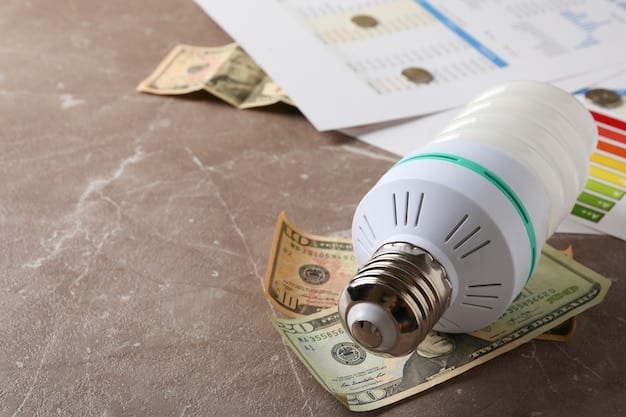Choosing Your Renewable Energy Provider: A 2025 Guide

Choosing the right renewable energy provider for 2025 involves assessing your energy needs, comparing provider plans and pricing, and verifying the provider’s commitment to sustainable practices and customer satisfaction.
Navigating the renewable energy market can be complex, but with the right information, you can make an informed decision. This comprehensive guide simplifies the process of how to choose the right renewable energy provider: a 2025 comparison guide, ensuring you’re powered by sustainable sources.
Understanding the Renewable Energy Landscape
The renewable energy sector is rapidly evolving, offering consumers more choices than ever before. Before diving into specific providers, it’s crucial to understand the different types of renewable energy and how they are delivered to your home or business.
Types of Renewable Energy Sources
Renewable energy comes from sources that are naturally replenished, such as sunlight, wind, and water. Each source has its own advantages and disadvantages.
- Solar Power: Harnessing energy from the sun using photovoltaic (PV) panels. Solar is ideal for sunny regions and can significantly reduce electricity bills.
- Wind Power: Utilizing wind turbines to generate electricity. Wind energy is most effective in areas with consistent wind patterns.
- Hydropower: Generating electricity from the movement of water. Hydropower is a reliable source but can have environmental impacts.
- Geothermal Energy: Extracting heat from the Earth’s core to produce electricity or heat buildings. Geothermal is a consistent source but is geographically limited.
Delivery Methods: Direct Supply vs. Renewable Energy Certificates (RECs)
Understanding how renewable energy is delivered is just as important as the source itself. There are two primary methods: direct supply and Renewable Energy Certificates (RECs).
Direct Supply: Your energy provider directly sources renewable energy and delivers it to your home or business through the grid.
Renewable Energy Certificates (RECs): Represent the environmental benefits of renewable energy generation. When you purchase RECs, you are supporting renewable energy projects, even if the electricity you use isn’t directly from a renewable source.
In conclusion, understanding the landscape is crucial, as you begin the process of how to choose the right renewable energy provider: a 2025 comparison guide.
Assessing Your Energy Needs and Goals
Before comparing providers, take a moment to evaluate your energy consumption and your goals for switching to renewable energy. This will help you narrow down your options and find a provider that aligns with your specific needs.

Calculate Your Energy Consumption
Review your past utility bills to determine your average monthly energy consumption. This will give you a baseline for comparing different renewable energy plans.
Define Your Renewable Energy Goals
Ask yourself why you want to switch to renewable energy. Are you primarily motivated by environmental concerns, cost savings, or a desire to support renewable energy development? Your goals will influence your choice of provider and plan.
- Environmental Impact: If your primary goal is to reduce your carbon footprint, look for providers that source a high percentage of their energy from renewable sources.
- Cost Savings: If cost is a major concern, compare the prices of different renewable energy plans to find the most affordable option.
- Supporting Renewable Energy: If you want to support the growth of the renewable energy sector, consider purchasing RECs or choosing a provider that invests in new renewable energy projects.
Understanding your energy consumption and goals is a critical step in learning how to choose the right renewable energy provider: a 2025 comparison guide.
Researching and Comparing Renewable Energy Providers
Once you have a clear understanding of your energy needs and goals, it’s time to research and compare different renewable energy providers. Look beyond just price and consider factors like customer service, contract terms, and the provider’s commitment to sustainability.
Key Factors to Consider When Comparing Providers
There are several key factors to consider when comparing renewable energy providers. These factors will help you assess the overall value and suitability of each provider.
Pricing and Plans: Compare the prices of different plans and look for any hidden fees or charges.
Contract Terms: Review the contract terms carefully, paying attention to the length of the contract, cancellation fees, and auto-renewal policies.
In summary, understanding these factors can give you clarity when considering how to choose the right renewable energy provider: a 2025 comparison guide.
Understanding Renewable Energy Plans and Pricing Structures
Navigating the pricing structures of renewable energy plans can be confusing. Providers offer a variety of plans, each with its own pricing model. Understanding these structures is essential for making an informed decision.
Types of Renewable Energy Plans
There are several common types of renewable energy plans, each with its own advantages and disadvantages. Take the time to research each potential type.
- Fixed-Rate Plans: Lock in a fixed price for electricity for the duration of your contract. This provides price certainty but may not be the cheapest option if energy prices fall.
- Variable-Rate Plans: The price of electricity fluctuates based on market conditions. This can save you money when prices are low, but you’re also exposed to the risk of price spikes.
- Time-of-Use Plans: Charge different rates for electricity depending on the time of day. This can save you money if you can shift your energy consumption to off-peak hours.
Decoding Pricing Structures: What to Look For
Pay attention to the following to ensure your financial success with energy sourcing.
Price per Kilowatt-Hour (kWh): Compare the price per kWh of different plans to determine the most affordable option.
Minimum Usage Fees: Some plans charge a minimum usage fee if you don’t consume a certain amount of electricity each month.

Understanding plans and strategies will provide insight to how to choose the right renewable energy provider: a 2025 comparison guide.
Verifying Provider Credentials and Certifications
Ensuring that your chosen renewable energy provider is reputable and certified is a crucial step. This verification provides assurance that the provider meets industry standards and ethical guidelines.
Importance of Certifications and Standards
Certifications and standards serve as a benchmark for quality and credibility in the renewable energy industry.
Green-e Certification: This certification ensures that the renewable energy being sold meets strict environmental and consumer protection standards.
You can feel confident knowing you are getting the right guidance for how to choose the right renewable energy provider: a 2025 comparison guide.
Making the Switch and Managing Your Renewable Energy Plan
Once you’ve selected a renewable energy provider and plan, it’s time to make the switch. This process typically involves signing a contract, setting up billing, and coordinating the transition with your current utility.
Steps to Transition to Renewable Energy
The transition to renewable energy is typically straightforward, but it’s important to follow these steps to ensure a smooth process.
Sign a Contract: Review the contract carefully and make sure you understand all the terms and conditions before signing.
Set Up Billing: Provide your billing information and choose your preferred payment method.
Knowing the steps to transition you’ll be well on your way to understanding how to choose the right renewable energy provider: a 2025 comparison guide.
| Key Point | Brief Description |
|---|---|
| 💡 Energy Needs | Assess your energy use to pick the right plan. |
| 💰 Pricing | Compare costs and contract terms carefully. |
| ✅ Certifications | Verify provider is certified for reliability. |
| 🔄 Transition | Follow steps to switch seamlessly. |
Frequently Asked Questions
▼
RECs represent the environmental benefits of renewable energy generation. Purchasing RECs supports renewable energy projects, even if your electricity isn’t directly from a renewable source.
▼
Look for certifications like Green-e, which ensures the renewable energy provider meets strict environmental and consumer protection standards, ensuring credibility.
▼
A fixed-rate plan locks in a consistent electricity price for the duration of your contract, offering stability but potentially missing out on savings if energy prices decrease.
▼
Consider pricing, contract terms, customer service, and the provider’s commitment to sustainability. Check hidden fees, contract length, and ethical practices before deciding.
▼
Generally, transitioning is straightforward: sign a contract, set up billing, and coordinate with utilities. Ensuring a seamless switch following these steps is key for transition.
Conclusion
Choosing the right renewable energy provider in 2025 involves careful assessment of your energy needs, thorough research into available options, and a clear understanding of pricing structures and provider credentials. By following this comparison guide, you can make an informed decision that aligns with your environmental and financial goals, paving the way for a sustainable future.





